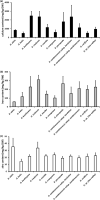Wild edible yams from Madagascar: New insights into nutritional composition support their use for food security and conservation
- PMID: 38268876
- PMCID: PMC10804101
- DOI: 10.1002/fsn3.3757
Wild edible yams from Madagascar: New insights into nutritional composition support their use for food security and conservation
Abstract
Yams (Dioscorea species) are an important food resource in Madagascar, where both cultivated winged yam (D. alata) and wild edible yams are consumed. However, there is limited knowledge on the nutrient composition of wild edible yams in Madagascar, and on how they compare with the cultivated winged yam. Therefore, in this study, nine wild edible yam species, one with two subspecies from Madagascar (D. bako, D. buckleyana, D. irodensis, D. maciba, D. orangeana, D. pteropoda, D. sambiranensis subsp. bardotiae and subsp. sambiranensis, D. seriflora, and Dioscorea species Ovy valiha), were analyzed for their nutrient composition, compared with cultivated D. alata. They include 6/6 of the most favored wild edible yam species in Madagascar. New nutrient composition data (protein, carbohydrate/starch, energy, lipid, β-carotene, and minerals) are presented for these nine wild edible yam species. The results show that they contain comparable levels of lipids and starch to D. alata, but none are better sources of protein than D. alata. The results show that D. irodensis contains a significantly higher β-carotene content when compared to all other edible yams analyzed, and that D. buckleyana, D. irodensis, and D. sambiranensis subsp. bardotiae have a higher calcium content than cultivated D. alata, while all nine wild edible yam species analyzed contain a higher iron content, compared to cultivated D. alata. The nutrient composition data presented could provide new incentives to conserve wild edible yams and inform on strategies to select Dioscorea species for sustainable cultivation and use, providing opportunities to enhance future food security in Madagascar.
Keywords: Dioscorea; carotenoids; macronutrients; micronutrients; minerals; protein; yams.
© 2023 The Authors. Food Science & Nutrition published by Wiley Periodicals LLC.
Conflict of interest statement
The authors declare no conflict of interest.
Figures



Similar articles
-
Nutritional assessment of yam (Dioscorea alata) tubers.Plant Foods Hum Nutr. 1994 Jul;46(1):33-9. doi: 10.1007/BF01088459. Plant Foods Hum Nutr. 1994. PMID: 7971785
-
Comparative plastomic analysis of cultivated Dioscorea polystachya and its close relatives provides insights on the inter- and intraspecific phylogenies and potential wild origins of domestication.BMC Plant Biol. 2024 Dec 26;24(1):1255. doi: 10.1186/s12870-024-06003-6. BMC Plant Biol. 2024. PMID: 39725934 Free PMC article.
-
First Report of Cucumber mosaic virus in Yams (Dioscorea spp.) in Ghana, Togo, and Republic of Benin in West Africa.Plant Dis. 2008 May;92(5):833. doi: 10.1094/PDIS-92-5-0833B. Plant Dis. 2008. PMID: 30769616
-
An underutilized orphan tuber crop-Chinese yam : a review.Planta. 2020 Sep 21;252(4):58. doi: 10.1007/s00425-020-03458-3. Planta. 2020. PMID: 32959173 Free PMC article. Review.
-
Potential of Neglected and Underutilized Yams (Dioscorea spp.) for Improving Nutritional Security and Health Benefits.Front Pharmacol. 2020 Apr 24;11:496. doi: 10.3389/fphar.2020.00496. eCollection 2020. Front Pharmacol. 2020. PMID: 32390842 Free PMC article. Review.
References
-
- Afiukwa, C. A. , Ogah, O. , Ugwu Okechukwu, P. C. , Oguguo, J. O. , Ali, F. U. , & Ossai, E. C. (2013). Nutritional and antinutritional characterization of two wild yam species from Abakaliki, Southeast Nigeria. Research Journal of Pharmaceutical, Biological and Chemical Sciences, 4, 840–848.
-
- Alam, M. K. , Sams, S. , Rana, Z. H. , Akhtaruzzaman, M. , & Islam, S. N. (2020). Minerals, vitamin C, and effect of thermal processing on carotenoids composition in nine varieties orange‐fleshed sweet potato (Ipomoea batatas L.). Journal of Food Composition and Analysis, 92, 103582. 10.1016/j.jfca.2020.103582 - DOI
-
- Alamu, E. O. , Maziya‐Dixon, B. , Sibeso, C. , Parkes, E. , & Dixon, A. G. (2020). Variations of macro‐ and microelements in yellow‐fleshed cassava (Manihot esculenta Crantz) genotypes as a function of storage root portion, harvesting time, and sampling method. Applied Sciences, 10, 5396. 10.3390/app10165396 - DOI
-
- Andriamparany, J. N. , Brinkmann, K. , Jeannoda, V. , & Buerkert, A. (2014). Effects of socio‐economic household characteristics on traditional knowledge and usage of wild yams and medicinal plants in the Mahafaly region of South‐Western Madagascar. Journal of Ethnobiology and Ethnomedicine, 10, 82. 10.1186/1746-4269-10-82 - DOI - PMC - PubMed
-
- AOAC . (2000). Official methods of analysis of AOAC International (17th ed.). USA Association of Analytical Communities.
LinkOut - more resources
Full Text Sources

